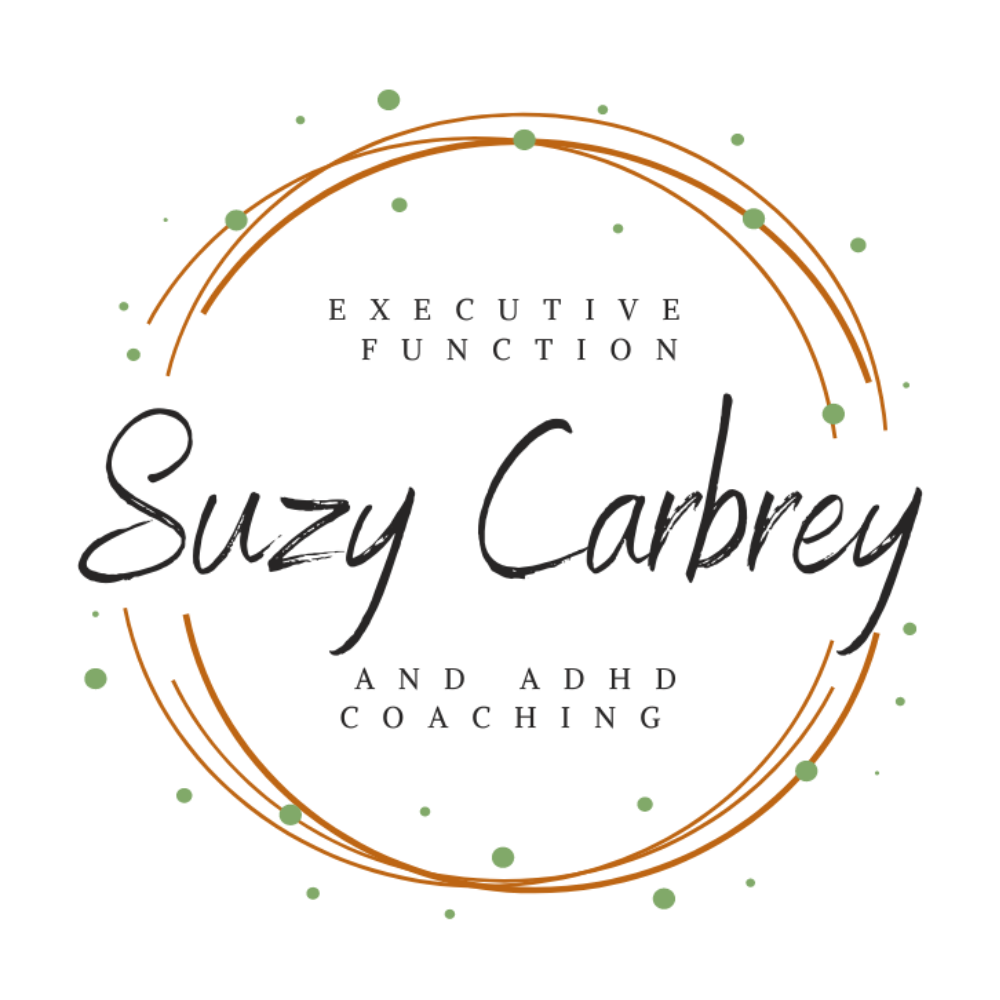Empowering Executive Function is written by Suzy Carbrey
Managing ADHD and improving executive functioning can be challenging, but understanding the interplay between your state, the story you tell yourself, and the strategies you implement can be transformative. Tony Robbins famously highlights the importance of these three elements—state, story, and strategy—in achieving breakthroughs in any area of life. For adults with ADHD, this concept becomes even more relevant, offering a framework to navigate challenges like focus, motivation, and follow-through.

The Power of State: Setting the Foundation for
Empowering Executive Functioning
Your state refers to your emotional and mental condition at any given moment. It influences how you perceive the world, interact with others, and tackle tasks. For adults with ADHD, managing your state is crucial because it directly impacts your ability to initiate tasks, maintain focus, and regulate emotions. A heightened state of stress or overwhelm can lead to paralysis or avoidance, making even simple tasks feel insurmountable.
To optimize your state, it’s essential to develop strategies that help you shift from a disempowered state to an empowered one. Practices like deep breathing, mindfulness, or physical movement can reset your mental and emotional outlook, setting a positive tone for the day and making it easier to approach tasks with clarity and energy.
Shifting and Improving Mood
Optimizing your state often begins with shifting your mood. Here are some strategies:
- Gratitude Practice: Take a moment to identify three things you’re grateful for. This simple practice can quickly shift your focus from what’s going wrong to what’s going right, improving your mood and outlook.
- Music Therapy: Create a playlist of songs that uplift and energize you. Listening to music that resonates with positive emotions can be a powerful tool for shifting your mood.
- Visualization: Spend a few minutes visualizing a place where you feel calm and happy. Immerse yourself in the sights, sounds, and feelings of that place to help reset your emotional state.
- Affirmations: Use positive affirmations to counter negative self-talk. Repeating statements like “I am capable” or “I am in control of my day” can reinforce a more positive mindset.
Boosting or Resetting Energy Levels
Especially during an afternoon slump, finding quick and easy ways to boost or reset your energy is key. Consider these strategies:
- Physical Movement: Engage in a quick burst of activity, like stretching, walking, or doing jumping jacks. Physical movement increases blood flow and helps shake off sluggishness.
- Hydration: Dehydration can contribute to fatigue, so make sure you’re drinking enough water. A glass of cold water can also have an immediate refreshing effect.
- Light Exposure: Step outside for a few minutes to get some natural light. Sunlight helps regulate your circadian rhythm, improving alertness and energy levels.
- Power Naps: A short nap (10-20 minutes) can recharge your energy without leaving you groggy. Set an alarm to avoid oversleeping.
- Healthy Snacks: Opt for a snack that combines protein and healthy fats, like nuts or yogurt, to provide a sustained energy boost without the crash that comes from sugary treats.
By intentionally changing your state, shifting your mood, and boosting your energy, you can approach tasks with greater clarity and vigor.

Crafting Your Story: The Narratives We Live By
Empowering Executive Functioning
The story you tell yourself shapes your beliefs about what’s possible. For those with ADHD, the internal narrative can often be filled with self-doubt, frustration, and a sense of inadequacy. These stories can become self-fulfilling prophecies, reinforcing negative patterns and limiting your ability to overcome challenges.
However, by rewriting your story, you can shift your perspective from one of limitation to one of potential. Ask yourself: What is the story I’m telling myself about my ability to succeed? How can I reframe this narrative in a way that empowers me? By adopting a more constructive and positive story, you open the door to new possibilities and strategies that can lead to success.
Recognizing and Shifting Self-Talk
Self-talk plays a critical role in shaping your internal narrative. It’s the constant stream of thoughts running through your mind, often unnoticed, that can either uplift or undermine you. Recognizing and shifting negative self-talk is key to rewriting your story.
- Awareness: Start by becoming aware of your self-talk. Notice when you’re engaging in negative or self-defeating thoughts. Are you telling yourself that you’re not capable, smart enough, or that you’ll never change? These thoughts often come automatically, but with practice, you can learn to identify them.
- Challenge Negative Thoughts: Once you’ve recognized negative self-talk, challenge it. Ask yourself: Is this thought really true? What evidence do I have to support or refute it? Often, negative self-talk is based on irrational beliefs or past experiences that don’t reflect your current abilities or potential.
- Bridge Thoughts: Shifting from negative to positive self-talk can feel overwhelming, especially if the new thought feels too far from your current belief. Instead of jumping from “I’ll never succeed” to “I’m always successful,” try a bridge thought like, “I’m learning how to succeed, and I’m getting better each day.” Bridge thoughts help you move gradually from a fixed mindset to a growth mindset, making the transition more believable and achievable.
- Growth Mindset: Adopting a growth mindset means believing that your abilities and intelligence can be developed with effort, learning, and perseverance. Instead of seeing challenges as threats, view them as opportunities to grow. When faced with difficulties, ask yourself: What can I learn from this? How can this experience help me improve? By shifting your focus from limitations to possibilities, you reinforce a positive internal narrative that supports your growth and success.
- Positive Affirmations: Use positive affirmations to reinforce new, empowering narratives. Create statements that reflect the story you want to live by and repeat them daily. For example, “I am capable of achieving my goals,” or “I am resilient and can overcome challenges.” Over time, these affirmations can help rewire your brain to focus on your strengths and potential.
By recognizing and shifting your self-talk, incorporating bridge thoughts, and embracing a growth mindset, you can transform the story you tell yourself. This new narrative not only empowers you but also equips you with the strategies needed to navigate the unique challenges of ADHD with resilience and confidence.

Implementing Strategies: Turning Ideas into Action when Empowering Executive Functioning
While state and story set the stage, strategy is the action plan that brings your goals to life. It’s the practical, step-by-step approach you take to overcome obstacles and achieve your objectives. For adults with ADHD, effective strategies are those that align with your strengths and address your unique challenges.
A good strategy considers how your brain works, allowing for flexibility and adaptability. This might include breaking tasks down into smaller steps, using visual aids, or creating routines that support consistency. The key is to find strategies that work for you rather than trying to fit into a one-size-fits-all model.
Tools and Techniques to Support Executive Functioning
To implement these strategies effectively, leverage tools and techniques that cater to the unique demands of ADHD. Here are some methods to enhance executive functioning:
- Task Breakdown and Time Management: Breaking tasks into smaller, manageable steps is crucial. Consider using digital tools that allow you to organize tasks into checklists with deadlines. Pair this with time management techniques, such as using a timer app or a visual timer, to help maintain focus and prevent overwhelm.
- Visual Aids: Visual reminders can keep important tasks and deadlines top of mind. Consider using digital planners, whiteboards, or even sticky notes strategically placed around your workspace as constant prompts. Customize digital dashboards to align with your personal workflow for added efficiency.
- Routine Creation and Habit Tracking: Establishing routines can help build consistency, even when motivation is low. Consider using tools that gamify the process of building new habits, turning everyday tasks into a game where you earn rewards for consistency. Analog options like bullet journals can also serve as both a planner and a habit tracker, offering a tangible way to stay on course.
- Environmental Modifications: Create an environment that minimizes distractions and promotes focus. This might include decluttering your workspace, using noise-canceling headphones, or setting up specific areas for different tasks, such as a reading nook or a writing desk. Consider using tools that block distracting websites during work hours to stay focused.
- External Accountability and Support: Engage with accountability partners or join groups where you can share goals and track progress. This might include working with a coach, joining a support group, or using apps that allow you to set commitments and have friends or a community hold you accountable.
- Mind Mapping and Visualization: Mind mapping is a technique used to visually organize information, making it easier to brainstorm, plan, and see the relationships between different ideas. Imagine starting with a central idea or goal, and then branching out into smaller, related tasks or concepts. This process helps you break down complex projects into more manageable parts and see the connections between them. Whether you prefer using digital apps or traditional paper and pen, mind mapping can help you organize your thoughts and keep track of everything. Visualization techniques, such as imagining the completion of tasks or projects, can also boost motivation and clarify your path forward.
- Digital Assistants and AI: Leveraging technology like digital assistants to set reminders, create to-do lists, or even automate certain tasks can save mental energy. AI tools can also assist in breaking down projects into actionable steps or provide prompts to overcome task initiation barriers.
By combining these tools and techniques with a strategy tailored to your strengths, you can create a supportive framework that makes turning ideas into action both achievable and sustainable.

The Interconnection: How State, Story, and Strategy Work Together for Empowering Executive Functioning
State, story, and strategy are deeply interconnected. When you’re in a positive state, you’re more likely to create empowering stories about your abilities, which in turn fuels the development of effective strategies. Conversely, if you’re in a disempowered state, the story you tell yourself might be one of defeat, leading to ineffective or non-existent strategies.
For adults with ADHD, understanding this dynamic can be a game-changer. By consciously working on improving your state, rewriting your story, and developing personalized strategies, you can create a powerful cycle of growth and achievement.
Final Thoughts on
Empowering Executive Functioning

Tony Robbins’ model of state, story, and strategy provides a valuable framework for anyone seeking lasting change. For adults with ADHD, this approach offers a clear path to overcoming the unique challenges of executive functioning. By focusing on these three interconnected elements, you can unlock your potential, achieve your goals, and live a more empowered and fulfilling life.
Learn more about Empowering Executive Functioning with Online Coaching for Executive Functioning / ADHD
Ready to gain control and enhance your executive functioning? As an experienced and compassionate coach, I specialize in providing support for executive functioning and ADHD. To embark on your journey, please reach out to me at 708-264-2899 or email hello@suzycarbrey.com to schedule a FREE 20-minute discovery call consultation.
With a background as a speech-language pathologist, I have a strong foundation in executive functioning coaching. My graduate degree program in SLP placed a significant emphasis on cognition, including executive functions, and I have years of experience in medical rehabilitation, providing cognitive-communication therapy. Additionally, I have completed an ADHD Services Provider certification program, I am Solutions-Focused Brief Therapy Diamond Level 1 certified and I am trained in the Seeing My Time® executive functioning curriculum.
Experience the convenience and effectiveness of online coaching, backed by studies that demonstrate equal results to in-person services. Parents, professionals, and emerging adults love the convenience and privacy of receiving coaching from their own homes.
Whether you reside in Chicago, Milwaukee, Indianapolis, Kansas City, or anywhere else around the globe, I am here to assist you. Schedule your discovery call consultation today, and I eagerly anticipate the opportunity to work with you!
Please note that although I am a certified speech-language pathologist, all services Suzy Carbrey LLC provides are strictly coaching and do not involve clinical evaluation or treatment services. If you require a formal speech therapy evaluation and treatment, please inform me, and I can provide appropriate recommendations.

